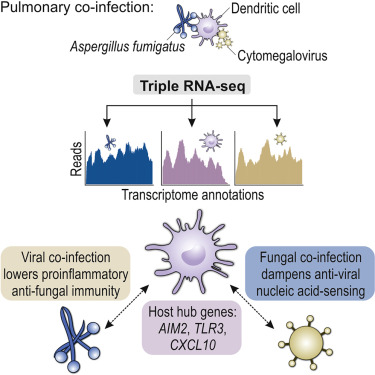Triple RNA sequencing dissects gene expression of virus and fungi in infection processes
CHATTANOOGA, Tenn – Organ and stem cell transplants are proven and frequently used methods in everyday modern clinical practice. However, even when performed regularly in specialized centers, some patients still experience a number of serious complications afterward.
Among other things, infections with fungi and viruses can jeopardize therapeutic success. For example, coinfection with cytomegalovirus, which belongs to the family of Herpes viruses, and the fungus Aspergillus fumigatus can be critical. This combination of pathogens poses a serious medical threat in organ and stem cell transplantation.
When viruses and fungi join forces
A team of scientists from several German research institutions and clinics has now developed a new method to examine these two pathogens, their interaction with each other, and with the human cells infected by them.
The central result: coinfection with the two pathogens is more “than the sum of its parts”. Viruses and fungi interact synergistically in the human organism, where they trigger certain genes that only become active when infected with both pathogens simultaneously.
The study involved scientists from the Julius Maximilian University of Würzburg (JMU), the Würzburg University Hospital (UKW), the Leibniz Institute for Natural Product Research and Infection Biology in Jena and the Helmholtz Institute for RNA-based Infection Research (HIRI) in Würzburg, a site of the Braunschweig Helmholtz Centre for Infection Research (HZI). The results have now been published in the journal Cell Reports.
New insights thanks to a novel technology
“For our study, we have developed a method called Triple RNA-seq,” explains Alexander Westermann. He is a junior professor at the Chair of Molecular Infection Biology I at JMU, as well as a group leader at the HIRI. Together with Jürgen Löffler from UKW and Sascha Schäuble, he is one of the senior authors of the study.
The scientists have advanced an established method that has been an integral part of infection research for years: dual RNA-seq.
The term “RNA-seq” is short for RNA-sequencing: This technique enables the simultaneous and precise determination of the activities of thousands of genes at the RNA level in a high-throughput process, thus enabling the identification and better understanding of the changes occurring in the course of diseases.
The development of dual RNA sequencing has made it possible to document not only the gene activity of a pathogen but also the reaction of the host cell affected by it. This has enabled scientists to trace complex causal chains over the course of an infection.
Research on immune cells
Now, Triple RNA sequencing dissects the gene expression of three players and their interplay in infection processes.

